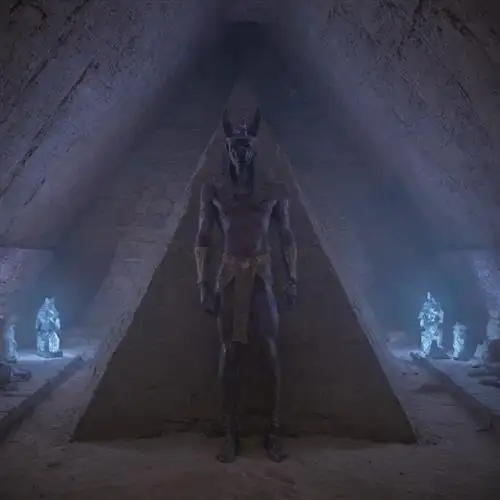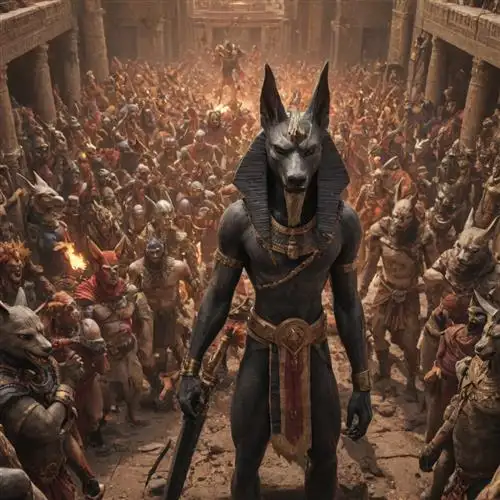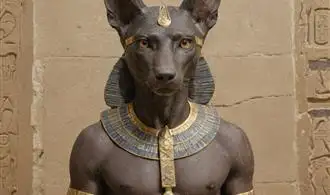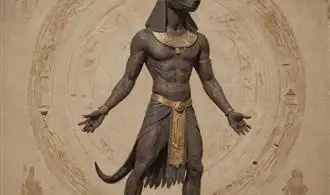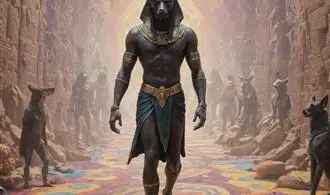
The Origins of Anubis
The enigmatic figure of Anubis, the canine-headed Egyptian god, has captivated the imagination of scholars and enthusiasts alike for millennia. This enigmatic deity's origins can be traced back to the earliest dynastic periods, where he was revered as the guardian of the dead and the protector of the sacred rituals associated with the afterlife. Understanding the complex tapestry of Anubis's origins is crucial to unraveling the broader significance of this powerful figure in the pantheon of ancient Egyptian mythology.
Anubis's origins are deeply rooted in the ancient Egyptian belief system, which saw the divine as inextricably linked to the natural world. The jackal-like features of Anubis were likely adopted from the observation of these cunning predators, which were often found prowling the edges of cemeteries and necropoli, scavenging for the remains of the deceased. This association with death and the afterlife was further reinforced by the belief that jackals were capable of navigating the treacherous underworld, guiding the souls of the departed to their final resting place.
The precise origins of the Anubis cult remain a topic of scholarly debate, but it is generally accepted that the deity's prominence grew in tandem with the development of funerary practices and the elaboration of the Egyptian conception of the afterlife. In the earliest dynastic periods, Anubis was closely associated with the embalming process, overseeing the mummification of the deceased and ensuring the proper preparation of the body for its journey to the afterlife. Solve Your Problems with Anubis and the Afterlife This intimate connection with the rituals of death and the transition to the next life cemented Anubis's position as a central figure in the Egyptian pantheon, and his cult spread throughout the length and breadth of the Nile Valley.
The Evolving Roles of Anubis
Anubis, the ancient Egyptian deity associated with mummification and the afterlife, has held a complex and multifaceted role in the cultural and religious landscape of ancient Egypt. Over time, this pivotal figure has undergone significant transformations, reflecting the ever-changing needs and beliefs of the Egyptian people.
One of the primary shifts in Anubis' roles can be seen in his relationship to the process of mummification. Initially, Anubis was closely tied to the embalming and preparation of the deceased, serving as a guide and protector during this critical transition. He was responsible for the crucial step of weighing the heart of the deceased against the feather of truth, determining the individual's worthiness for the afterlife. This intimate connection with the burial rites and the journey to the afterlife solidified Anubis' position as a central figure in ancient Egyptian religious thought.
However, as the cult of Osiris grew in prominence, Anubis' role began to evolve. Osiris, the god of the underworld, became the primary focus of the afterlife, with Anubis assuming a more supporting role as the embalmer and guardian of the deceased. This shift in emphasis did not diminish Anubis' importance, but rather transformed him into a vital intermediary between the mortal and divine realms, ensuring the safe passage of the deceased into the afterlife.
Furthermore, Anubis' symbolic significance expanded beyond the realm of the afterlife. He was also associated with healing, protection, and the restoration of order. In this capacity, Anubis was invoked in various rituals and ceremonies, serving as a source of guidance and security for the living. His presence was often invoked to ward off malevolent spirits and to ensure the well-being of individuals and communities.
The Controversial Aspects of Anubis
Anubis, the ancient Egyptian deity associated with death, mummification, and the afterlife, has long been a subject of fascination and controversy. As one of the most important figures in the Egyptian pantheon, Anubis' role and significance have been heavily debated by scholars and enthusiasts alike. In this exploration, we delve into the controversial aspects of this enigmatic deity, shedding light on the complexities and controversies that surround his legacy.
One of the most controversial aspects of Anubis is his potential role in the embalming process. While Anubis is often depicted as the patron of embalmers and the mummification process, some scholars have questioned the extent of his direct involvement. The specifics of Anubis' participation in the complex rituals of mummification remain a topic of ongoing discussion, with differing interpretations and theories proposed by various experts.
Another area of controversy surrounding Anubis is his relationship with other deities, particularly Osiris, the god of the afterlife. The interplay between Anubis and Osiris has been the subject of much debate, with some scholars suggesting a potential rivalry or even a shifting of responsibilities over time. The nuances of their divine roles and the evolution of their relationship have been the focus of intense scholarly scrutiny.
Additionally, the symbolism and iconography associated with Anubis have been the subject of much debate. The jackal-headed depiction of Anubis has led to discussions about the significance of this animal representation and its potential connections to the cult of the dead. Scholars have explored the various interpretations and theories surrounding the choice of the jackal as Anubis' symbolic form.
Furthermore, the role of Anubis in the afterlife and the weighing of the heart ceremony has been a topic of intense interest and controversy. The precise nature of Anubis' involvement in this pivotal moment of the Egyptian afterlife journey has been the subject of extensive research and debate, with scholars grappling with the complexities and nuances of this crucial ritual.
The Enduring Legacy of Anubis
Anubis, the ancient Egyptian deity associated with mummification and the afterlife, has captivated the minds of scholars and enthusiasts alike for millennia. This enigmatic figure, often depicted with the head of a jackal, has left an indelible mark on the cultural and religious landscape of Egypt, and its influence continues to reverberate throughout the modern world.
At the heart of Anubis' enduring legacy lies its multifaceted role in the complex and intricate funerary rituals of ancient Egypt. As the guardian of the dead, Anubis was responsible for overseeing the embalming process, ensuring the proper preservation of the deceased's mortal remains. This sacred duty was not merely a practical matter but rather a deeply symbolic act, as Anubis was believed to facilitate the transition of the soul into the afterlife.
The importance of Anubis in the Egyptian pantheon is further underscored by its prominent placement in the mythological narratives surrounding the judgment of the dead. In the famous weighing of the heart ceremony, Anubis was tasked with weighing the deceased's heart against the feather of truth, determining the worthiness of the individual for eternal life in the afterworld. This pivotal moment in the Egyptian conception of the afterlife cemented Anubis' role as a gatekeeper and arbiter of the soul's fate, a responsibility that has inspired countless artistic and literary depictions throughout history.
Beyond its religious significance, Anubis has also left an indelible mark on the visual culture of ancient Egypt. The iconic image of the jackal-headed deity has been immortalized in a wealth of artifacts, from ornate sarcophagi and funerary masks to intricate wall reliefs and sculptures. These enduring representations not only bear witness to the reverence and awe with which Anubis was held but also serve as a testament to the enduring power of Egyptian mythology in shaping the artistic and cultural landscapes of the ancient world.
The legacy of Anubis, however, extends far beyond the confines of ancient Egypt. In the modern era, the jackal-headed deity has continued to captivate the popular imagination, appearing in various forms of media, from literature and film to video games and art. This enduring fascination speaks to the universality of the themes and concepts associated with Anubis, as the deity's role as a guardian of the dead and a guide to the afterlife resonates with audiences across cultures and time periods.


